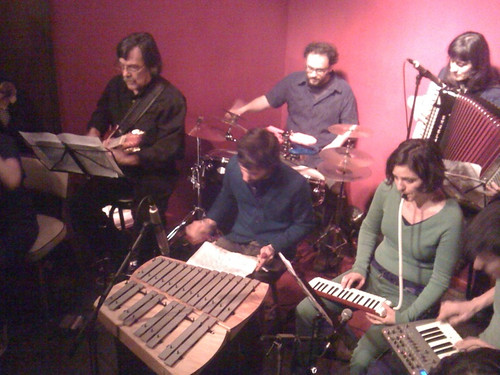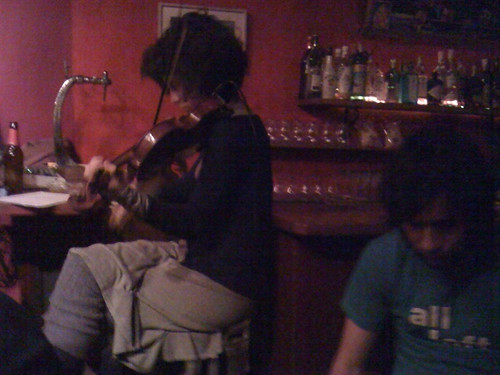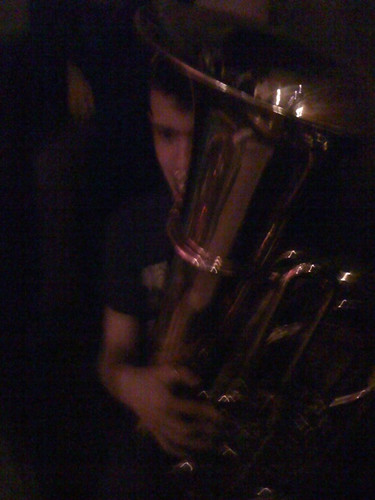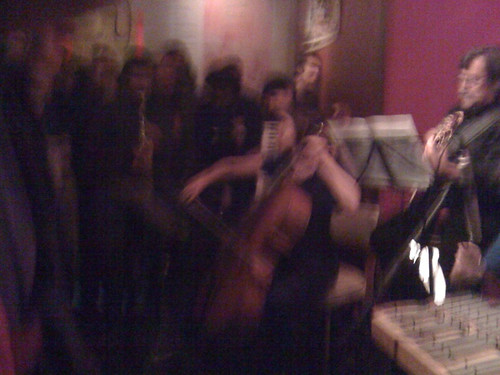In C de Terry Riley... Amb membres de Cabo San Roque, La Lidia, Surfing Sirles,
La Orquesta del Caballo Ganador, Manos de Topo, Le Petit Ramon, Mil Pesetas,
Za!, Blay Tritono i Secta Sònica.
14 músics i uns 100 espectadors en menys de 100 m2. crec que tots ens ho vam passar prou bé. no es podia fer foto de tot l'ensemble alhora per manca d'angle. les fotos són d'on érem de peu.
In CPerforming DirectionsAll performers play from the same page of 53 melodic patterns played in sequence. Any number of any kind of instruments can play. A group of about 35 is desired if possible but smaller or larger groups will work. If vocalist(s) join in they can use any vowel and consonant sounds they like.

Patterns are to be played consecutively with each performer having the freedom to determine how many times he or she will repeat each pattern before moving on to the next. There is no fixed rule as to the number of repetitions a pattern may have, however, since performances normally average between 45 minutes and an hour and a half, it can be assumed that one would repeat each pattern from somewhere between 45 seconds and a minute and a half or longer.
It is very important that performers listen very carefully to one another and this means occasionally to drop out and listen. As an ensemble, it is very desirable to play very softly as well as very loudly and to try to diminuendo and crescendo together.

Each pattern can be played in unison or canonically in any alignment with itself or with its neighboring patterns. One of the joys of IN C is the interaction of the players in polyrhythmic combinations that spontaneously arise between patterns. Some quite fantastic shapes will arise and disintegrate as the group moves through the piece when it is properly played.
It is important not to hurry from pattern to pattern but to stay on a pattern long enough to interlock with other patterns being played. As the performance progresses, performers should stay within 2 or 3 patterns of each other. It is important not to race too far ahead or to lag too far behind.

The ensemble can be aided by the means of an eighth note pulse played on the high c’s of the piano or on a mallet instrument. It is also possible to use improvised percussion in strict rhythm (drum set, cymbals, bells, etc.), if it is carefully one and doesn’t overpower the ensemble. All performers must play strictly in rhythm and it is essential that everyone play each pattern carefully. It is advised to rehearse patterns in unison before attempting to play the piece, to determine that everyone is playing correctly.
The tempo is left to the discretion of the performers, obviously not too slow, but not faster than performers can comfortably play.
It is important to think of patterns periodically so that when you are resting you are conscious of the larger periodic composite accents that are sounding, and when you re-enter you are aware of what effect your entrance will have on the music’s flow.

The group should aim to merge into a unison at least once or twice during the performance. At the same time, if the players seem to be consistently too much in the same alignment of a pattern, they should try shifting their alignment by an eighth note or quarter note with what’s going on in the rest of the ensemble.
It is OK to transpose patterns by an octave, especially to transpose up. Transposing down by octaves works best on the patterns containing notes of long durations. Augmentation of rhythmic values can also be effective.
If for some reason a pattern can’t be played, the performer should omit it and go on.
Instruments can be amplified if desired. Electronic keyboards are welcome also.
IN C is ended in this way: when each performer arrives at figure #53, he or she stays on it until the entire ensemble has arrived there. The group then makes a large
crescendo and diminuendo a few times and each player drops out as he or she wishes.







